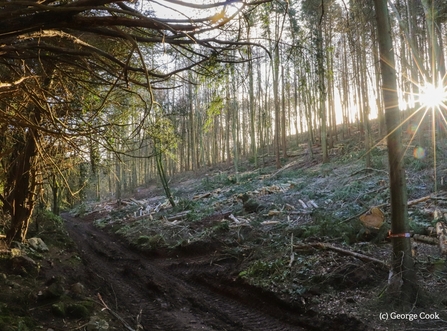However, not all woodlands are naturally occurring and some are instead planted by hand. These are called plantation woodlands and are usually planted as a tree crop to provide a source of timber. At the end of the First World War, the cover of woodland in the UK was at a historic low covering just 5% of the country which led to a lot of plantation woodland creation. Today, according to the Woodland Trust’s State of UK’s Woods and Trees report, woodland covers around 12% of the UK. Half of this cover is native woodland whilst half the UK is non-native conifer plantation.
What is a 'Plantation Woodland'?
(c) George Cook

Take a walk through a plantation woodland and you will be able to notice the differences compared to a natural woodland. Straight lines of densely packed trees will stretch off into the distance in monotonous, straight lines. The trees are planted so close together that the woodland looks dark and moody. Little light will reach the woodland floor, so it becomes barren with no understorey developing and as a result can be devoid of wildlife. Being close together, the trees will grow upwards towards the light resulting in uniform straight trunks. This is good for timber but less good for wildlife. Bats, for example, need to roost in cracks in the bark and birds nest between branches and in nooks and crannies which are absent in these unnaturally straight trees. Being all the same age, there will also be little or no standing dead wood within these plantation woodlands, another important food source for many insects and fungi. Scientific research also shows that native woodlands with multiple different species of tree, are not only better at supporting wildlife and promoting biodiversity but also act as better sinks of carbon and therefore help tackle climate change better than plantation woods.

Because of this vast difference between plantation and native natural woodland, Avon Wildlife Trust is carrying out projects such as Wilder Woodlands across our Goblin Combe nature reserve and surrounding areas. This project will see us removing some of this plantation cover, introducing new tree species, creating standing dead wood, putting up bat boxes, giving more space to the older trees and creating glades and rides within the woodland. Ultimately creating a healthier, more diverse woodland ecosystem across the landscape.

(c) George Cook

